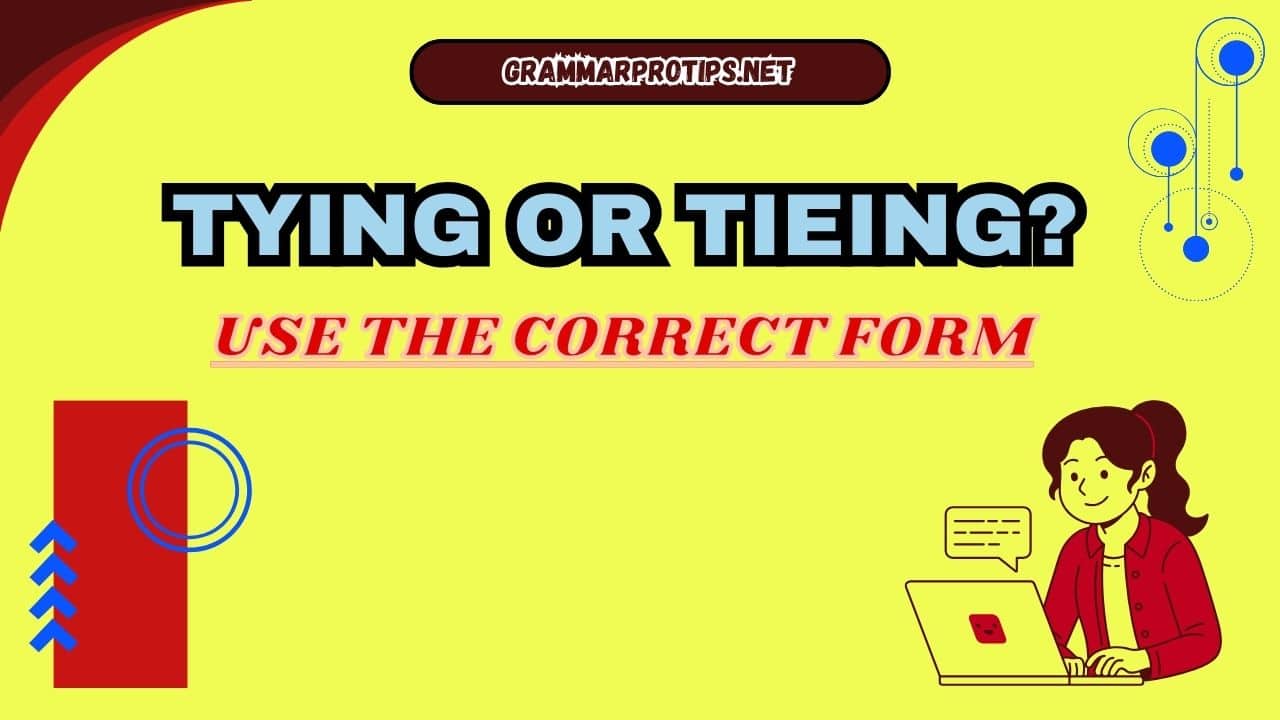The English language can be full of nuances, and few things are as puzzling as deciding between tying and tieing.
Although these two words may seem very similar, one of them is generally preferred over the other in modern English, while the other is considered outdated.
Understanding the difference between these forms can drastically improve your spelling accuracy and help you avoid common mistakes in both professional and casual writing.
In this comprehensive guide, we’ll discuss everything you need to know about tying and tieing, including their historical background, grammar rules, and practical examples.
This will be a deep dive into the topic that will ultimately help you master this aspect of English spelling.
We’ll also discuss some misused spellings, offer real-life examples such as email scenarios, and share tips for avoiding mistakes.
By the end of this article, you’ll have a strong grasp of the correct usage and how to make your writing more precise and accurate.
Understanding the Difference Between Tying and Tieing
The confusion between tying and tieing stems from the fact that they both seem to represent the same action fastening, binding, or knotting.
The primary difference lies in their historical usage and modern-day conventions.
Tying: The Modern and Correct Form
Tying is the most common and widely accepted form in contemporary English. It is used as the present participle or gerund of the verb “tie,” meaning to fasten, bind, or secure something with a knot, rope, or ribbon.
Examples of tying in modern usage include:
- Tying shoes: The most basic and frequent use of the word is when fastening shoes with laces.
- Tying knots: In various contexts such as sailing, hiking, or decorative crafts.
- Tying a ribbon: Whether you’re wrapping a gift or styling your hair, tying ribbons is a common task.
Examples of Tying in Action:
- Email Scenario: Subject: Tying Up Loose Ends Before the Deadline
Hi Laura,
Just wanted to follow up and make sure we’re tying up all the tasks before the project deadline tomorrow. Can you confirm if all the final reports are completed?
Thanks,
Sam - Tying Shoes:
“She bent down to tie her shoes before heading out for the jog.” - Tying a Knot:
“John carefully began tying a knot in the rope to secure the boat to the dock.” - Tying the Knot in Weddings:
“After years of dating, they were finally tying the knot in a beautiful ceremony on the beach.”
As you can see, tying is used in the most common, everyday activities involving knots or bindings, and this form is the preferred choice in modern English.
Tieing: The Outdated and Less Common Form
Historically, tieing was also used as a valid form of the verb “tie.”
In older texts, particularly from the 16th through 19th centuries, tieing was considered grammatically acceptable.
However, this spelling has since fallen out of favor and is rarely used in contemporary writing. It is mostly seen today in historical documents, literature, or poetic styles.
In modern English, tieing is generally considered incorrect.
While it may still appear in some older writings or be used for artistic effect, tying is overwhelmingly the preferred form in all types of writing.
Examples of Tieing in Historical Contexts:
- Historical Fiction Example:
“The sailor was tieing the rigging securely to prepare for the storm.” - Poetic Style:
In poetry, the form tieing might be used for stylistic purposes to evoke an older, more classical tone.
“The maiden sat in silence, tieing ribbons to her hair.”
Though you might encounter tieing in certain settings, you should avoid using it in everyday writing.
Historical Background of Tying and Tieing
To fully understand why tying became the preferred form and tieing was relegated to the past, it’s essential to explore the evolution of English spelling.
The Historical Use of Tieing
The English language, especially before the standardization of spelling, was subject to many variations.
Different dialects, regional influences, and the lack of widely accepted spelling conventions meant that many words were spelled phonetically.
Tieing was simply an earlier accepted form of tying.
In older English texts, particularly from the Renaissance through the 18th century, tieing was often used in the same way we use tying today.
For example, Shakespeare might have written tieing in his plays or sonnets to maintain the rhythm of the verse.
The Shift to Tying
The shift toward tying occurred as English began to standardize its spelling conventions.
As dictionaries were published, like Samuel Johnson’s A Dictionary of the English Language in 1755, spelling began to stabilize.
This led to the widespread adoption of tying over tieing in everyday usage.
The spelling rules became clearer, and tying was considered grammatically correct, while tieing slowly faded from regular use.
Tying vs. Tieing: Common Mistakes to Avoid
One of the most frequent errors in English writing is using the outdated tieing form instead of the correct tying.
Many writers, especially those who are unfamiliar with the historical context or who have seen tieing used incorrectly in various places, mistakenly use it in their own writing.
Here are some examples of common mistakes:
- Incorrect: “I’ll be tieing my shoes in a second.”
- Correct: “I’ll be tying my shoes in a second.”
- Incorrect: “She was tieing the ribbon around the gift box.”
- Correct: “She was tying the ribbon around the gift box.”
It’s easy to confuse the two, especially since tieing might look correct at a glance. However, always remember that tying is the proper form to use in contemporary writing.
Tying and Tieing in Different Contexts
1. Tying Your Shoes
One of the most common uses of tying is for fastening shoes or laces. Whether you’re teaching a child or getting ready for your morning jog, tying your shoes is something everyone does.
- Example:
“Before heading out the door, she stopped to tie her shoes tightly.”
2. Tying Knots
Another everyday use of tying is when you’re tying knots.
This could be for any number of reasons, from tying a rope to secure something to creating intricate decorative knots for crafts.
- Example:
“The sailor spent hours tying knots in the ropes to secure the sails.”
3. Tying a Ribbon
Tying a ribbon might be necessary for a variety of purposes, from wrapping a gift to styling hair or securing an object.
- Example:
“He carefully tied the ribbon around the box, making a neat bow on top.”
4. Tying the Knot in Weddings
Tying the knot is a well-known idiomatic expression referring to marriage.
This expression comes from the idea of physically tying a knot during a wedding ceremony as a symbol of the couple’s commitment to one another.
- Example:
“After a beautiful ceremony, they were finally tying the knot at the church.”
Tying vs. Tieing
Here’s a helpful table that contrasts tying and tieing in various contexts.
| Context | Tying | Tieing |
|---|---|---|
| Modern Usage | Preferred spelling | Outdated and less common |
| Shoes | Tying shoes | Tieing shoes (incorrect in modern English) |
| Knots | Tying a knot | Tieing a knot (historical or poetic) |
| Ribbons | Tying a ribbon | Tieing a ribbon (historical or poetic) |
| Weddings | Tying the knot (marriage) | Tieing the knot (archaic usage) |
| Writing Accuracy | Correct in contemporary writing | Incorrect for modern usage |
This table clearly highlights the distinction between the two forms, focusing on when and where each is used.
While tying is suitable for most modern-day contexts, tieing is reserved for historical writing or specific artistic purposes.
Why Tying is the Preferred Form
The modern English spelling rules have standardized tying as the correct form to use, as it aligns with contemporary spelling patterns.
The historical spelling of tieing is seen as outdated and often considered a misused spelling in everyday writing.
Using tying ensures your writing reflects current conventions and promotes writing accuracy.
Spelling Rules and Writing Accuracy
When writing, it’s essential to adhere to the rules of grammar and spelling.
Incorrectly using tieing when you mean tying can create confusion and reduce the quality of your writing.
Keeping your spelling and grammar up to date will help ensure your work is clear, precise, and professional.
Conclusion: Tying is the Correct Form
In conclusion, tying is the preferred and correct form in modern English.
Whether you’re tying shoes, tying a knot, or tying the knot in marriage, always opt for the tying form in contemporary writing.
Tieing, on the other hand, is an outdated form that’s rarely used outside of historical or poetic contexts.
By following these guidelines and avoiding the confusion between tying and tieing, you’ll ensure your writing is both accurate and engaging.
Whether you’re writing an email, preparing for a presentation, or even penning a letter, using the correct form will elevate your work and help you communicate more effectively.
So, the next time you’re faced with the choice between tying or tieing, remember to choose tying, and your writing will reflect the clarity and accuracy that modern English demands.
Read more knowledgeable blogs on Grammar Pro Tips

Sienna Mauldon is a passionate writer and grammar expert. On her blog, she shares easy-to-follow guides to help readers master grammar rules and improve their writing. With a love for language and teaching, Sienna makes grammar simple and fun for everyone, from beginners to experienced writers.








